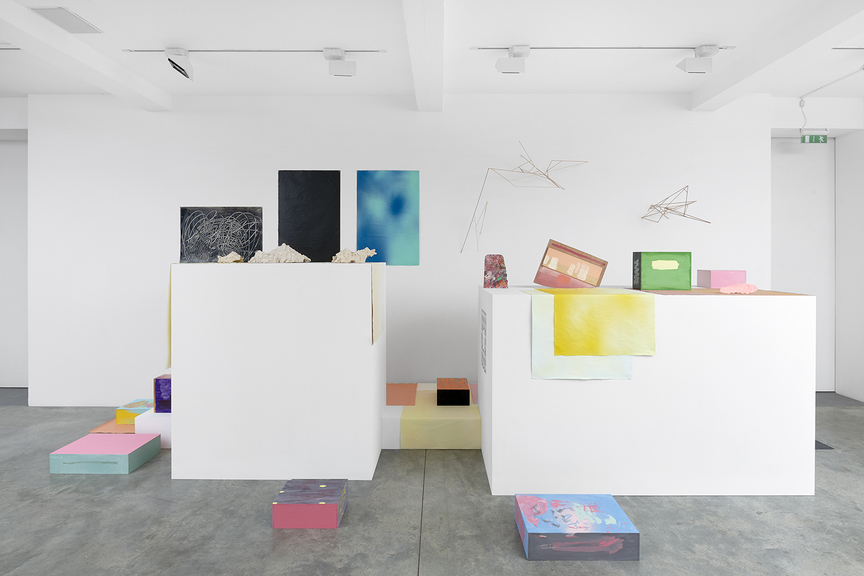-
From Current Issue
-
- Editor’s Letter Fire in the Heart
- Reviews I Gusti Ayu Kadek Murniasih
- Reviews 11th Seoul Mediacity Biennale: “One Escape at a Time”
- Dispatch Networked China
- One on One Monira Al Qadiri on Yukio Mishima
- Essays The rise of independent art spaces in pandemic-era Shanghai
- Features Tuan Andrew Nguyen
- Table of Contents
- Web Exclusives
- Archive
- Subscribe

R
E
V N
E
X
T
Installation view of “Nine Iranian Artists in London: The Spark is You,” Parasol Unit Foundation for Contemporary Art, London, 2019. Photo by Benjamin Westoby. Courtesy Parasol Unit Foundation for Contemporary Art.
Nine Iranian Artists in London: The Spark is You
In medieval Persia, writing in poetic verse was a requisite for scholars seeking credibility. Valued more highly than literature, scientists, historians and philosophers expressed their innovations and contentions through this genre. The verses functioned as both calligraphic works of art and the stuff of great performances. This rich heritage of poetic expression, which has survived millennia through multiple invasions and remains a key part of Iranian culture, ostensibly guided Ziba Ardalan in her curation of “Nine Iranian Artists in London: The Spark is You” at London’s Parasol Unit Foundation for Contemporary Art. Yet, in the show, the frame of Persia’s poetic heritage appeared tenuous. Poetry could only be understood as a latent—if at all present—element in the nine artist’s variegated use of narrative and metaphor. Though this thematic attempt to cohere the diverse works fell short, the displays were individually navigable, and, together, presented a dynamic cross-section of Iran’s contemporary art practices.
installation view of NAZGOL ANSARINIA’s The Mechanisms of Growth, Demolishing Buildings, Buying Waste, 2017, plaster, glue, PVC, pigment, dimensions variable, at “Nine Iranian Artists in London: The Spark is You,” Parasol Unit Foundation for Contemporary Art, London, 2019. Photo by Benjamin Westoby. Courtesy the artist and Green Art Gallery, Dubai.
Opening the show were Nazgol Ansarinia’s tales of contemporary Tehran’s real estate. An array of gray, smashed bricks and fragments of tiles were laid out on the floor. These plaster-cast replicas of rubble from Tehran commemorate the many buildings that have been pulled down to provide clean foundations for the high-rise living developments that now span the city. The installation, The Mechanisms of Growth, Demolishing Buildings, Buying Waste (2017), was accompanied by two films from the same year, both of which showed close-up shots of this ruthless destruction. A penetrating drumbeat resounds as laborers whack the walls that once comprised a family home. The final strike in a series of pickaxe wounds sends another structure tumbling. In a different scene, chunks of brickwork crumble to the floor and showers of dust pour through an open ceiling. The perpetrators of this destruction are chillingly ambivalent and the human consequences of this action conspicuously absent.
Installation view of KOUSHNA NAVABI’s Untitled (Tree Trunk), 2017, mixed media, 45 × 150 × 38 cm, at “Nine Iranian Artists in London: The Spark is You,” Parasol Unit Foundation for Contemporary Art, London, 2019. Photo by Benjamin Westoby. Courtesy the artist.
From there, the show shifted into the topic of exile—a condition with a lengthy history for Iranians. Successive regimes have created a large diaspora community who precariously reconcile the culture of home with that of a newly adopted environment. Assimilation, as brought about by imposed relocation, is the basis of Koushna Navabi’s sculpture, Untitled (Tree Trunk) (2017), of a suspended female corpse, carved from a log. The dismembered body was hung close to the ground, rotating from a stainless steel cord. A Persian kilim is wound around its head, snaking down to its waist. Below the waist, smooth bare wood is exposed and bordered by leathery cracked bark. A large hole, where the figure’s heart would be, is encircled by dribbling green paint, its hue matching the Iranian flag, while her mouth is open aghast. Cues to the source of the body’s pain lie in its materiality; it is scarred by its transplantation, and the clash of dueling cultures.
Elsewhere in the exhibition, artworks alluded to compelling Persian folk tales, which transcend geographic contours. Among them was Sam Samiee’s two capacious installations, The Fabulous Theology of Koh-i-noor (Theologia Theatrica de Koh-i-noor) and The Fabulous Theology of Darya-i-noor (Theologia Theatrica de Darya-i-noor) (both 2019). An irregular assortment of white plinths, colorful geometric three-dimensional shapes, balsa stick assemblages, Japanese rice-paper, painted canvases and curious ceramic objects comprise the landscapes. The tableaux links the history of two coveted diamonds, Koh-i-noor (“mountain of light”) and Darya-i-noor (“sea of light”) with the story of two powerful women told in One Thousand and One Nights. For Samiee, the women, whose names Sangehavak and Arvehavak reference the land and seas, embody female intuition and intelligence. The artist works them into the diamonds’ heady narratives of masculine power and conflict. Where the symbolism is subtle, the work is not. There is a whimsicalness to the mix of candy pink and turmeric yellow blocks, viscous brush strokes and spray painted panels that found parallels in the swooping markings of Navid Nuur’s two abstract paintings from the series “The Tuners” (2005– ). These canvases’ bright streaks and scribbles, which run across and out of the frame, seemingly want to represent words and take definite form. Their resistance to cohere was symptomatic of the show at large—a dynamic mix of idiosyncratic practices.
“Nine Iranian Artists in London: The Spark is You” is on view at the Parasol Unit Foundation for Contemporary Art, London, until September 8, 2019.
To read more of ArtAsiaPacific’s articles, visit our Digital Library.


















